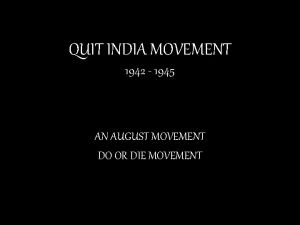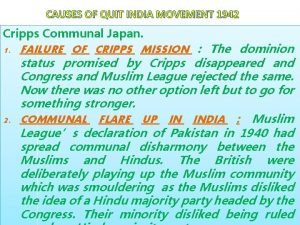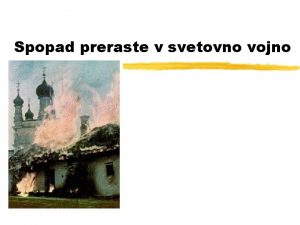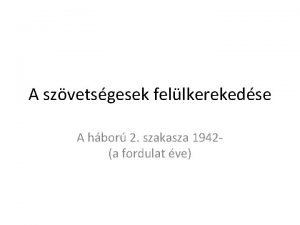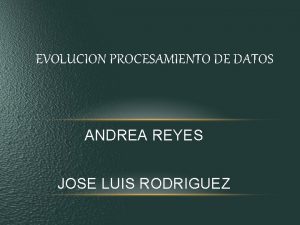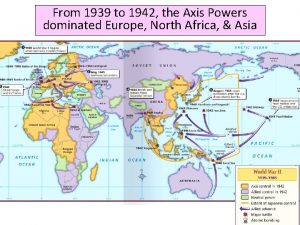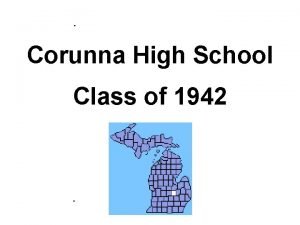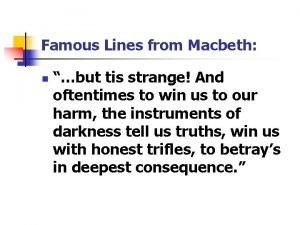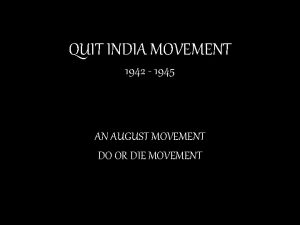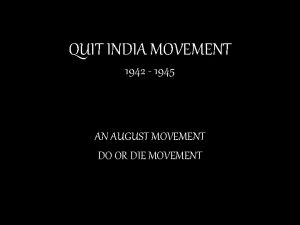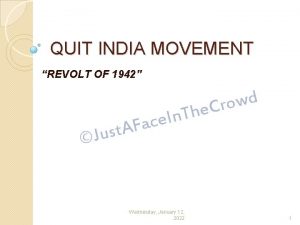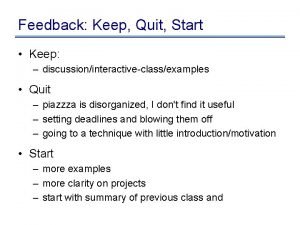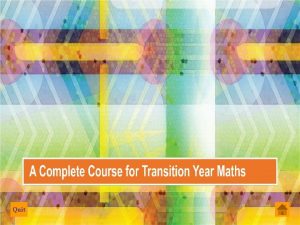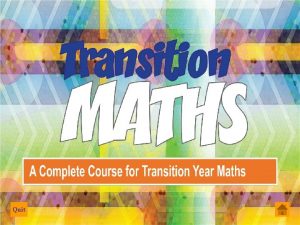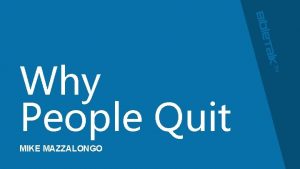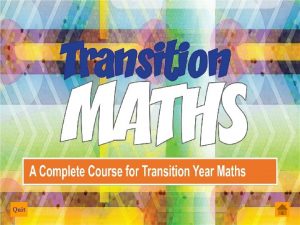QUIT INDIA MOVEMENT 1942 1945 AN AUGUST MOVEMENT
















- Slides: 16

QUIT INDIA MOVEMENT 1942 - 1945 AN AUGUST MOVEMENT DO OR DIE MOVEMENT

mass protest on nonviolent lines an orderly British withdrawal from India July 1942 Congress Working Committee : Wardha resolution : Quit India Resolution “British Rule in India must end immediately” All India Congress Committee at Bombay on August 7, 1942 nonviolent mass struggle under the leadership of Gandhi

Launching of the Movement Mohandas Karamchand Gandhi “Every Indian who desires freedom and strives for it must be his own guide urging him or her on a long hard road where there is no resting place and which leads ultimately to the in. Every one of you should from this moment onwards consider yourself freeman or woman and act as if you were free… I am not going to be satisfied wish anything short of freedom. You should do or die. We shall either free India or die in the attempt dependence of India”

causes Involvement of india in second world war Cripps’ Mission March 1942 “post dated cheque drawn on a crashing bank” Resolution for immediate independence

Spread of the movement mohandas karamchand gandhi Maulana Abul Kalam Azad Subhas chandra bose Mohammed ali jinnah Asoka Mehta Jaya Prakas Narayan Jawaharlal nehru Vallabhbhai Patel Rajendra Prasad Rajgopalachari Anugrah narayan sinha

Phases of quit india movement In the first phase of the Quit India Movement, there were processions, strikes and demonstrations The second phase of the movement saw raids in the government buildings and municipal houses. Along with this, post offices, railway stations and police stations were set on fire The third phase of Quit India movement began in September 1942. Mobs bombed police in places like Bombay, Uttar Pradesh and Madhya Pradesh Gradually, the movement gained back its peaceful form and continued till Mahatma Gandhi was released on May, 1944. This was the fourth phase of the movement

Spread of the movement Spread: Uttar Pradesh, Bihar, Bengal, Bombay, Odisha and Andhra Pradesh Centres: Satara of Maharashtra, Tamluk, Contai of Midnapore, Balurghat of West Dinajpur, Balia, Ajamgarh of Uttar Pradesh, Naogaon of Assam Places such as Ballia, Tamluk, Satara, Dharwar, Balasore and Talcher were Freed from british and native governments were formed

Features of quit india movement British Banned congress and arrested leaders NON VILOLENCE strikes, demonstrations, processions people attacked all symbols of the British government BOMBING OF GOVernment PLACES Establishment of independent governments Respond of British was terrible : military Brutality 1943: 90000 imprisoned and 1000 killed

When the peasants concentrated their offence on symbols of authority, there was the complete absence of anti-zamindar violence The Quit India Movement had initially been active in the urban areas, but soon it was the populace of the countryside, which kept the banner of revolt aloft for a longer time The participation was on many levels, school and college students remained in the forefront, women actively participated, and workers went on strikes

The Muslim League kept aloof, and the Hindu Mahasabha condemned the Movement The Indian Princes and the landlords were supporting the War effort and therefore did not sympathise with the movement Some Congress leaders like Rajagopalachari also did not participate The trend of underground revolutionary activity also started during this phase

Importance of quit India movement it kept the Congress united massive set of disturbance across the length and breadth of India British realised it would not be able to continue governing India for long and therefore started thinking of ways to exit India in a peaceful and respectable manner The movement got support from a vast variety of people; Students, teachers, labourers, business people, villagers, government officials, policemen, ladies - all took part in it Uniting India: gradual and slow transition from miniscale minority of freedom seekers to mass organization of freedom seekers

Jai Prakash Narayan escaped from Hazaribagh Jail and organised an underground movement During the Quit India movement, there were no any communal clashes During the movement, their repression was severe on for the people There was some public party of India, who did not support the Quit India movement 1942

The most important feature of the movement was : Russia was attacked by Nazi Germany, so the communist supported British war against Germany and the ‘Imperialist war’ changed into ‘peoples war’ to them In the novel, “Jagari” of Satinath Bhaduri has described the negative role of CPI, and other political parties adopted the different attitude towards the movement

Impact of quit India movement The ban on Congress was lifted and the leaders were released. The Cabinet Mission's constitutional proposal was accepted by the Congress in good faith. This led to the holding of general elections and the formation of the Interim Government at the centre consisting of leaders of all major political parties and Congress government in Madras (Chennai)

Impact of quit India movement However communal squabbles, war economic crisis, activities of the Razakars against Hindus, R. S. S. against Muslims, and Dravida Kazhakam against Brahmins, produced an uneasy political situation here. More important of the ills that upset the country just before the dawn of independence was the anarchical predatory activities of the Communist Party which organized violent strikes and armed uprisings in many parts of South India

Impact of quit India movement In order to curb the danger of the Communist onslaught, the Congress Government of Madras (Chennai) had to enact the Maintenance of Public Order Act of 1947 which provided for preventive detention, imposition of collective fines and censorship, control on meetings, processions, camps, drill sand parades, requisitioning of property and control of essential services. Hundreds of Communists were sent to jails on the strength of this Act. Thus strangely enough, the dawn of independence saw the severe imposition of restraints on individual freedom against which Congress fought for several decades
 Quit india movement
Quit india movement Cause of quit india movement
Cause of quit india movement Ce 31 juillet 1942 monpeurt
Ce 31 juillet 1942 monpeurt Prelomno leto 1942
Prelomno leto 1942 1942 a fordulat éve
1942 a fordulat éve Progol 1942
Progol 1942 Eastern front 1942 map
Eastern front 1942 map 1879-1942
1879-1942 What is cctv
What is cctv Deklaracija ujedinjenih naroda 1942
Deklaracija ujedinjenih naroda 1942 Delhi lift rules 1942
Delhi lift rules 1942 Goodguysww.
Goodguysww. Battle of midway june 1942
Battle of midway june 1942 Great stock market crash 1929
Great stock market crash 1929 Kamikaze
Kamikaze 1974-1942
1974-1942 Macbeth famous lines
Macbeth famous lines
